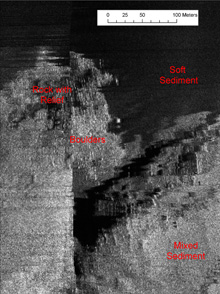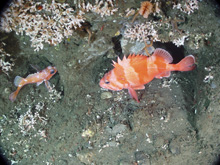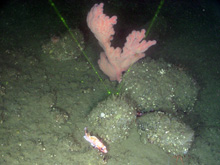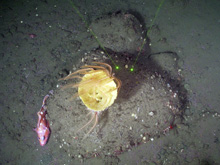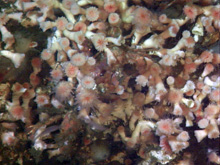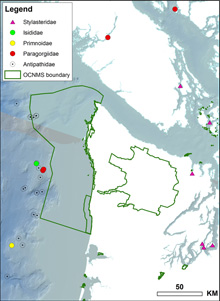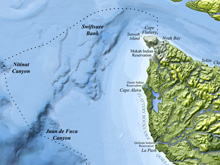
The Olympic Coast 2006 expedition dive targets included several sites along the Juan de Fuca Trough, which winds its way southwestward from the Strait of Juan de Fuca to the canyon head. Click image for larger view and image credit.
Deep-sea Coral Habitat in the Olympic Coast National Marine Sanctuary
Mary Sue Brancato, Olympic Coast National Marine Sanctuary (OCNMS)
Peter Etnoyer, Harte Research Institute for Gulf of Mexico Studies
Ed Bowlby, OCNMS
Jeff Hyland, National Centers for Coastal Ocean Science
In the Olympic Coast National Marine Sanctuary (OCNMS), the continental shelf along the Washington coast extends from 8 to 40 miles from the shore. Three submarine canyons cut into the shelf within the sanctuary boundary. For the Olympic Coast 2006: Deep-sea Coral Habitat expedition, our potential dive sites included areas on the shelf, as well as areas at the heads of the Nitinat, Juan de Fuca, and Quinault canyons, and several sites along the Juan de Fuca Trough and Canyon, which wind their way southwestward from the Strait of Juan de Fuca. The upper part of this feature – the Juan de Fuca Trough — is a complex, glacially carved, underwater fjord-like system. Farther offshore, the trough becomes the Juan de Fuca Canyon that cuts across the outer continental shelf and slope, ending in deep water at the base of the continental slope.
Forty-eight dive sites were identified as having hard-bottom substrates (boulder fields, canyon walls, ledges, or bedrock) potentially suitable for the growth of corals. We used side scan sonar imagery (see related Habitat Mapping article) to identify these substrates in non-canyon areas. In the canyons, where little high-resolution side scan data have been obtained, a literature review (Zimmermann 2003; Jagielo et al. 2003) of untrawlable areas yielded a few potential dive sites within our workable depth range (less than 1,000 m). Most of the 48 sites identified were boulder fields or, in some cases, single house-size boulders — one of which we nicknamed “The Monolith” (see related Monolith and Lophelia May 29 log). The hard substrates we observed are largely glacial deposits. However, the boulder patches and The Monolith are glacial erratics left either by the retreat of the Cordilleran ice sheet from Canada and the Olympic Peninsula, or carried to their locations by icebergs from the sheet and deposited on the often sand or silt shelf substrate.
We knew we would be able to survey only about one-fourth to one-half of the potential sites this year, but we plan to survey all of them in the future. With more bottom mapping, researchers will also identify additional potential coral-sponge sites. To date, only about 20 percent of the sanctuary is mapped using high-resolution side scan sonar, so there are likely many more potential dive sites. Sites to survey on the 2006 cruise were randomly selected from the 48. The random selection yielded only one canyon site for 2006 in the Juan de Fuca Canyon and several sites along the trough of this canyon.
The erratics and other hard substrates proved excellent indicators for corals: 14 of our 15 dive sites selected for hard-substrate features yielded corals. Corals are sessile, meaning they are stationary. Many corals prefer to settle on hard substrates. The planktonic larvae settle on this substrate and metamorphose into juvenile stages, they begin depositing a skeleton, and, if colonial, bud additional polyps. For this study, we used coral preference for settling on hard substrate as a clue as to where to locate them.
Prior to the Olympic Coast 2006 expedition, the distribution of corals in the OCNMS was largely unknown, limited to anecdotal reports by fishermen, scuba divers, previous submersible cruises undertaken by OCNMS, and independent researchers. The most comprehensive peer-reviewed report that includes the Olympic Coast is a publicly available database of nearly 3,000 geo-referenced northeast Pacific deep-coral records in seven “habitat-forming” families from ten record-keeping institutions in North America. The report was compiled by researchers at the Marine Conservation Biology Institute (Etnoyer and Morgan 2004). Now several years old, this database includes records from the Smithsonian National Museum of Natural History, NOAA Fisheries RACEBASE, Canadian Museum of Nature-Department of Fisheries and Oceans (CMN-DFO), California Academy of Science, and others. The geo-referenced records are ranked on a scale of one to four according to relative data quality (depending on the level of expertise) and to whether a physical sample was maintained for later inspection.
The main finding of “Habitat Forming Deep Sea Corals in the Northeast Pacific” (Etnoyer and Morgan 2004) was that deep corals were widespread on seamounts and continental shelves throughout the northeast Pacific, down to a depth of 4,700 m. Furthermore, the report identified a surprising paucity of records for the well-known Atlantic scleractinian coral, Lophelia pertusa. Groundtruth efforts suggested the data were largely a reflection of scientific reporting and research effort, as many corals were found on Gulf of Alaska seamounts where the database showed none. This has since been confirmed by recent expeditions in the Monterey Bay National Marine Sanctuary, in OCNMS in 2004, and by the Olympic Coast 2006 expedition.
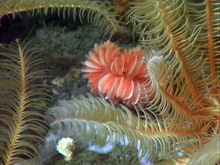
New to OCNMS, as a result of the 2006 survey, is the cup coral Desmophyllum. Click image for larger view and image credit.
In the United States, deep-sea coral communities are known to occur along the Atlantic Ocean, Gulf of Mexico, Caribbean, North Pacific/Alaskan region, and the central and western Pacific region (Morgan et al. 2006). They also have been observed in many other parts of the world, especially along outer continental shelves and slopes, canyon walls, and seamounts. Published records of habitat-forming deep-sea corals within OCNMS have been limited. Only one species of the hexacoral family Antipathidae (“black" corals), i.e., Bathypathes sp., had been documented prior to the present project (see review by Etnoyer and Morgan 2003). OCNMS has unpublished data from its prior 2000 to 2004 cruises, indicating the presence of the gorgonians Paragorgia and Lophogorgia (“bubblegum” corals), a few sea pens, the hydrocoral Stylaster venustus (“lace” coral), and Balanophyllia cup corals.
New to OCNMS, as a result of the 2004 pilot effort that launched the present study (Hyland et al. 2005, Bowlby et al. 2006) is the reef-building scleractinian coral Lophelia pertusa (family Caryophyllidae). The presence of Lophelia within sanctuary waters was confirmed at several additional sites on the present 2006 follow-up survey as well. Also new to OCNMS, as a result of the 2006 survey, are scleractinian cup corals of the genus Desmophyllum (family Caryophyllidae); one additional species of the hydrocoral genus Stylaster; the alcyonacean (soft coral) octocoral family Alcyoniidae (genus Anthomastus); two gorgonian octocoral families, Plexauridae (genus Swiftia) and Primnoidae (genus Plumarella); and several sea pens (pennatulacean octocorals), including the genus Umbellula (family Umbellulidae).
References:
Bowlby, E., J. Hyland, M.S. Brancato, C. Cooksey and S. Intelmann. 2006. "Preliminary Discoveries of Scleractinian Coral Lophelia pertusa and other Deep-sea Coral and Sponge Communities in the Olympic Coast National Marine Sanctuary." Abstract in the 3rd International Symposium on Deep-Sea Corals, Miami, Nov. 2005.
Etnoyer, P. and L. Morgan. 2003. "Occurrences of habitat-forming deep sea corals in the northeast Pacific Ocean." Marine Conservation Biology Institute, Redmond, WA, and National Oceanic Atmospheric Administration, Silver Spring, MD.
Hyland, J., C. Cooksey, E. Bowlby, M.S. Brancato, and S. Intelmann. 2005. "A Pilot Survey of Deepwater Coral/Sponge Assemblages and their Susceptibility to Fishing/Harvest Impacts at the Olympic Coast National Marine Sanctuary (OCNMS)." Cruise Report for NOAA Ship McArthur II Cruise AR-04-04: Leg 2. NOAA Technical Memorandum NOS NCCOS 15. NOAA/NOS Center for Coastal Environmental Health and Biomolecular Research, Charleston, SC. 13 p.
Jagielo, T.H., A. Hoffman, J. Tagart, and M. Zimmerman. 2003. "Demersal groundfish densities in trawlable and untrawlable habitats off Washington: Implications for the estimation of habitat bias in trawl surveys." Fishery Bulletin 101: 545-565.
Morgan, L.E., C.F. Tsao, J.M. Guinotte. 2006. "Status of deep sea corals in U.S. waters, with recommendations for their conservation and management." Marine Conservation Biology Institute, Bellevue, WA. 64.
NOAA Ocean Exploration. 2006. Davidson Seamount.
http://oceanexplorer.noaa.gov/explorations/06davidson/welcome.html
Zimmermann, M. 2003. "Calculation of untrawlable areas within the boundaries of a bottom trawl survey." Can. J. Fish. Aquat. Sci. 60:657-669.
Sign up for the Ocean Explorer E-mail Update List.














